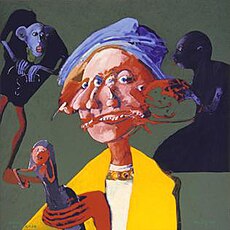Jean Tirilly


Jean Tirilly (born 1946) is a French painter, born in 1946 in Léchiagat, Brittany, France. He paints in the Outsider Art tradition legitimized by the German psychiatrist and art historian Hans Prinzhorn in the 1920s and popularized by the French abstract artist Jean Dubuffet in the 1950s. Tirilly's oeuvre stands among the strongest contemporary examples of Art Brut in Europe.
Early life
A self-taught artist, Tirilly only began painting in 1986 at age 40. Prior to his genesis of the late 1980s, he lived a largely piecemeal life, working odd jobs in Brittany while cultivating the elaborate visions of quotidian life in coastal Finistère that would later constitute his central subject. During a childhood marked by the absence of television, Tirilly's exposure to the absurd and unusual emerged ironically out of his provincial milieu: travelling circuses, drunken bouts between village mendicants, delinquent apple thieves, village idiots, and the host of passers-by and external influences that coloured Breton village life through the second half of the twentieth century.
Work
While it is difficult to ascribe influences to Tirilly's work, references to formative elements can be found. The macabre and lugubrious tone of his paintings is in part attributed to the artist’s esteem for the work of fifteenth century Dutch painter Hieronymus Bosch. Tirilly’s litany of contorted and tormented characters also calls to mind the late works of Francisco Goya, the figural works of Francis Bacon, the portraits of Lucian Freud, and the oneiric netherworlds of Odilon Redon, all the while maintaining characteristic differences between the influence and the influenced. His palette and swatch-like application of colour are strongly influenced by the Pont-Aven School artists, notably French compatriots Paul Gauguin, Paul Sérusier, and Émile Bernard, and the Art Brut tradition out of which he paints has as much to do with Jean Dubuffet as with general countercultural trends in post-World War II French art.
Tirilly's paintings are largely autobiographical, each image capturing childhood memories, family relatives, personal hardships, or ephemeral pleasures. Despite the apparent anguish in his work, humanizing elements such as family, friendship, or nostalgia often serve to temper bleakness with hope, suffering with redemption. Self-portraits are common but typically framed within the context of memory or dream. Tirilly’s paintings are meticulously catalogued via a system modelled on the Maya codices; a codex number is assigned to each completed work and subsequent paintings follow in numerical succession. He favours board and paper over canvas and acrylic paints over oils claiming the media are better suited to his work.
Tirilly's growing body of work is unique among the present output of autodidact artists working consciously within the rough-hewn parameters of Outsider Art. While the label is no doubt limiting, the artist's unusual ability to combine the fantastic with the banal, personal distortion with autobiography, and joy with torment is a strong example of the tripartite tension between academism, realism, and neophytism central to the traditions of Naïve, Raw, and Outsider art.
Selected exhibitions
- Biz’Art-Biz’Art, Le Vaudioux, France
- Galerie Benoot, Knokke-le-Zoute, Belgium
- Galerie Jakez, Pont-Aven, France
- Galerie Zaiß, Aalen, Germany
- SüdWestGalerie, Niederalfingen, Germany
Selected collections
- Collection de l’Art Brut, Lausanne, Switzerland
- Musée d’Art Spontané, Brussels, Belgium
References
- Danchin, Laurent et al. Jean Tirilly: Un poète des couleurs (A Colour Poet) [exhibition catalogue]. Geneva: La Baconnière, 2007.
External links
- Collection de l'Art Brut (Lausanne, Switzerland)
- Musée d'Art Spontané (Brussels, Belgium)
- The Fascinating World of Jean Tirilly
- Jean Tirilly: Recent Works (with additional work by Lucie Ludwiczak)
- Artfacts.net
- Artprice.com
- Raw Vision Magazine
- Art Brut Connaissance & Diffusion (ABCD)
